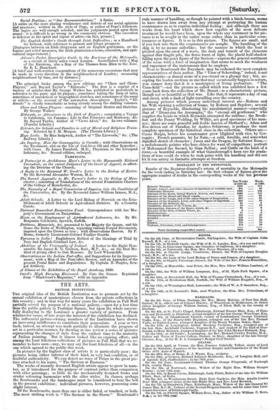THE ARTS.
BRITISH MTh. U nON.
THE original idea of the British Institution was to promote art by the annual exhibition of masterpieces chosen from the private collections in this country ; and in that way for many years the exhibition in Pall Mall partially served the purpose of a national gallery,—open for a less time than the public gallery in Trafalgar Square, but upon the whole success- fully displaying to the Londoner a greater variety of pictures. From whatsoever cause, of late years the interest of the exhibition has declined. The influential picture-owning members of the Institution have shown an increasing indifference to contribute their possessions. A year or two back, indeed, an attempt was made partially to illustrate the progress of art in a particular manner, by showing at one review a series of pictures representing the changes of style from the earliest time to the maturity of Italian painting. But it almost looked like an expiring effort; and among the least felicitous collections of pictures in Pall Mall that we re- member to have seen—nay, we may say the least felicitous of all—is the one which opened to the public this week.
In pictures by the highest class of artists it is particularly poor; the pictures being either inferior of their kind, in very bad condition, or of doubtful authenticity. We can detect no trace of Titian in the great pic- ture attached to his name, "The Saviour at Emmaus."
The works of recently deceased English artists appear to grow in num- ber, as if introduced for the purpose of contrast rather than comparison with older paintings ; so little do the mechanically designed forms and cruder colouring harmonize with the older styles. In classes, perhaps the Rembrandts and the landscapes must be considered to bear the bell in the present exhibition ; individual pictures, however, possessing some slight interest.
Of the Rembrandts, more than one is either faded, or touched, or both. The most striking work is "The Saviour in the Storm." Rembrandt's rude manner of handling, as though he painted with a birch-broom, seems to have drawn him away from any attempt at portraying the human countenance so as to express individual feeling; and although there are works from his hand which show how capable of the most delicate treatment he would have been, upon the whale any sentiment in his pic- tures is to be sought in the entire scene rather than in particular coun- tenances or figures. It is so in this picture. The figures are small, and if you look into them the countenances are nought. The handling of the ship is by no means sailorlike ; but the manner in which the boat is pitched upon the crest of a wave, the dash and tumult of the elements against that fragile pile, the fierce burst of light, the placid half-shadow falling upon thcquiet figure of the Saviour—express the general sentiment of the scene with a force of imagination that seems to mock the weakness and vagueness of the instruments that he employs. Next to Itembrandt the Ruysdaels may be reckoned the most complete representatives of their author. The "View of Scheveling," indeed, is not characteristic—a dismal scene of a sea-strand on a gloomy day ; but, ex- cepting the leaden medium as one that may occasionally happen in nature, you cannot deny that it is a masterpiece of living portraiture. "The Corn-field"—not the picture so called which was exhibited here a few years back from the collection of Mr. Stuart—is a characteristic picture, though not so beautiful as that was. Like that, it represents a day of sun. and aloud, with a dash of light travelling over the country. Among pictures which possess individual interest are—Rubens and his Wife viewing a collection of Game, by Rubens and Snyders ; several pictures of Reynolds, illustrating his unsubatantial manner—especially that of " Dionysius the Areopagite," the "eternal old gentleman" who supplies the heads in which Reynolds attempted the sublime ; the Break- fast and the Penny Wedding, by Wilkic, are good specimens of his man- ner; there are some graceful and feeble fancies of Stothard's ; Adam and Eve driven out of Paradise, by Andrea Schiavone, is perhaps the most complete specimen of the historical class in the collection. Others are- Cwsar Borgia, before his countenance grew blighted with vice, by Cor- reggio ; French peasants, by Le Nain,—a cold, forcible, and somewhat dignified sketch of character ; Jason and the Dragon, by Salvator Rosa,— a melodramatic painter who here shines for want of competitors; portrait of Mohammed the Second, by Giaa Bellini ; and. Cattle on the bank of a river,—a beautiful example of what Gainsborough's keen eye for grada- tions of tone could do when he took pains with his handling and did not let it run astray in fantastic attempts at freedom.


























 Previous page
Previous page